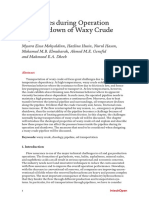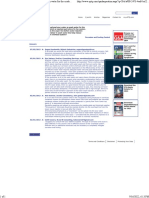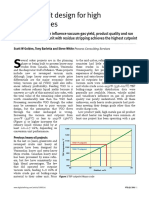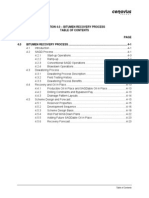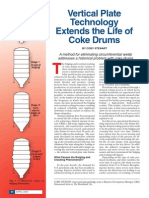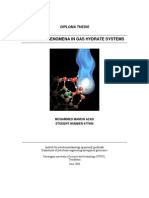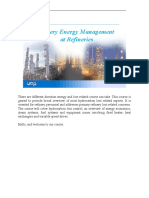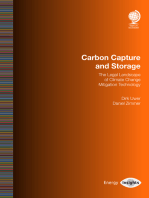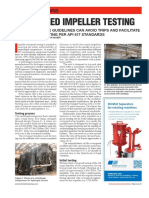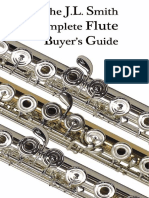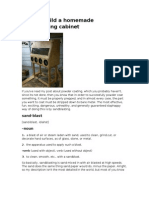Professional Documents
Culture Documents
Desalting Heavy Canadian Crudes PDF
Desalting Heavy Canadian Crudes PDF
Uploaded by
Anonymous 2TfNdCgOriginal Description:
Original Title
Copyright
Available Formats
Share this document
Did you find this document useful?
Is this content inappropriate?
Report this DocumentCopyright:
Available Formats
Desalting Heavy Canadian Crudes PDF
Desalting Heavy Canadian Crudes PDF
Uploaded by
Anonymous 2TfNdCgCopyright:
Available Formats
Desalting heavy Canadian crudes
Effective desalting requires large desalters and attention to all variables
associated with good desalter performance
Tom Collins Forum Energy Technologies
Tony Barletta Process Consulting Services
H
eavy Canadian crudes from Alberta and Heavy Canadian crudes
Saskatchewan are some of the most chal- For many years, US refiners have processed
lenging crudes to desalt because of their heavy conventional crudes or heavy synthetic
oil properties, composition and contaminants. crudes from Venezuela. BCF 17 is an example of
The geographic location of the producing basin conventional crude, whereas Merey is a blend of
and, to some extent, the production method light crude and Orinoco bitumen. Examples of
determine the degree of desalting difficulty due Venezuelan synthetic heavy crudes are
to variability in filterable solids, viscosity, PetroZuata and Hamaca, which are blends of
“cutterstock” composition, asphaltene content, coker products (sometimes hydrotreated) and
naphthenic acid content and other contaminants. Orinoco bitumen. Heavy Canadian crudes are
Even though many of these crudes are between similar to the Venezuelan crudes with respect to
18.5-22° API gravity, their desalting characteris- desalting difficulty, with the added challenge of
tics are not the same. For example, heavy high filterable solids. Two types of heavy
Canadian crudes such as Cold Lake or Canadian crudes are encountered. They are:
Lloydminster B are easier to desalt than bitu- • Conventional heavy crudes, such as Bow River
men-derived blends from Northern Alberta. and Lloydminster B
Heavy Canadian crude production is increasing, • Bitumens, diluted with synthetic crudes
so more refiners will be exposed to increasing produced from cokers and resid hydrocrackers
volumes of these crudes. or diluted with condensate.
The purpose of the desalter is to remove Bitumens are produced in the Cold Lake, Peace
contaminants and chlorides from the raw crude River and Athabasca regions, with the majority
oil. The reduction in chlorides reduces corro- of future production by steam-assisted gravity
sion and thereby improves reliability and run drainage (SAGD) methods. Heavy Canadian
length. Most refiners target a four-to-six-year crudes contain varying amounts of filterable
run length between maintenance turnarounds solids, hard-to-remove chlorides, amines and
on their crude units. Crude and vacuum unit H2S scavengers from the production process. The
(CDU/VDU) run length has been materially filterable solids are iron oxides, iron sulphides,
reduced when processing large percentages of sand and clay.
crudes derived from heavy Canadian bitumen, By definition, bitumens contain high asphaltene
especially from Northern Alberta. Poor desalter concentrations, which present problems when
performance is one of the major contributors they precipitate from the crude oil either in the
to the shortened run length. This article desalter or the preheat train. Bitumens mixed
presents an overview of critical desalter design with paraffinic condensates and other paraffinic-
and operating considerations for heavy type crudes increase the likelihood of asphaltene
Canadian crude processing, focusing on salt precipitation and stable rag layer formation in
removal. These same design and operating the desalter.
requirements apply to other heavy opportunity A significant problem with desalting heavy
crudes. Canadian crude is the generation of a stable
www.digitalrefining.com/article/1000566 Sour & Heavy 2012 1
emulsion. Large amounts of solids, H2S scaven- and corrosion, too. Piping, exchangers, ejector
gers and tramp amines stabilise the emulsion. equipment and drums have all been severely
corroded, with loss of containment occurring in
Consequences of poor desalting several instances. Rapid laydown of amine chlo-
Desalter performance is generally considered ride salts in the top of the atmospheric crude
good when desalted crude salt content is less column is relatively common and, increasingly,
than one pound of salt per thousand barrels the internals in the top of vacuum columns foul
(ptb) of crude. When large percentages of heavy with chloride salts. Atmospheric crude columns
Canadian crude are processed, desalted crude with top pumparounds can have very high corro-
salt content can be chronically high (3-5 ptb) or sion rates in the piping, pumps, exchangers and
the desalter can have periodic upsets, leading to control valves.
extremely high salt content for short intervals. In Vacuum column light vacuum gas oil pumpa-
either case, a high salt content in desalted crude rounds (LVGO) and vacuum preflash column top
significantly increases crude unit corrosion. pumparounds have shown a high metal loss.
Additionally, some heavy Canadian and other These chlorides eventually make their way to
opportunity crudes contain difficult-to-remove downstream hydrotreating equipment, where
organic and inorganic chlorides, requiring special higher corrosion rates have also been observed.
treating chemistry. Other consequences of poor desalting include
A portion of the salt leaving the desalter hydro- severe exchanger fouling from poor filterable
lyses to HCl in the atmospheric and vacuum solids removal in conjunction with poor
heaters. The amount of hydrolysis depends on exchanger design.
the heater temperature, the type of salt and the
presence of other compounds such as naphthenic Desalter variables
acids contained in the crude. Many refiners inject Larger-than-typical desalters are required to
caustic downstream of the desalter to convert desalt heavy Canadian crude. Most crude units
chlorides that hydrolyse to more stable sodium designed for light or even moderately heavy
chloride (NaCl), to reduce the HCl level in the crudes require additional desalter volume to satis-
crude overhead system. This practice helps factorily desalt heavy Canadian crude. Some
reduce chlorides. However, if the desalted crude refiners have tried to defer investment in addi-
salt content is in the 3-6 ptb range, even addi- tional desalting by operating the first- and
tional caustic will not materially improve second-stage desalters in parallel. The trade-off
reliability. from converting a two-stage desalter to a single
A portion of the thermally stable NaCl remain- stage has been a high desalted crude salt content
ing in the desalted crude, which does not (3-6 ptb), high corrosion rates and poor reliabil-
hydrolyse in the atmospheric heater, will break ity. Controlling corrosion with single-stage
down to HCl in the vacuum heater. Hence, corro- desalting and caustic addition has proven difficult
sion rates and fouling in the vacuum column for heavy Canadian crude processing.
overhead system can be very high relative to Due to the difficulties associated with desalting
conventional crudes. Corrosion in the vacuum heavy Canadian crude, it is equally important to
column overhead system and salt laydown in the pay special attention to other critical desalter
top of the vacuum column have become much parameters. The overall performance will depend
more common with heavy Canadian crude on desalter size, as well as attention to these
processing. This same problem is also common other variables:
with heavy Venezuelan and other opportunity • Operating temperature
crudes. • Amount and quality of water
Poor desalting generally leads to a very high • Water and oil mixing
corrosion rate in the atmospheric crude and • Mud washing to remove solids
vacuum column overhead systems. It is not • Brine cooling heat exchanger design
uncommon for the top of the columns to experi- • Chemical treatment
ence corrosion and/or salting. Peripheral • Desalter design
equipment such as top pumparounds and prod- • Transformer size.
uct rundown systems have experienced fouling Crude preheat trains must have the flexibility
2 Sour & Heavy 2012 www.digitalrefining.com/article/1000566
to meet the desalter temperature
required for optimum perform-
ance. The preheat train must
have the flexibility to vary
desalter temperature irrespec-
tive of crude blend changes. This
means the ability to shift heat to
and from the raw crude exchang-
ers based on the desalter
requirements.
Optimum desalter temperature
depends on the specific crude or
crude blend, and it should be an
operating variable, not a conse-
quence of the exchanger network
design. Many existing crude units
were designed for light or moder- Figure 1 Severe fouling in the crude column top pumparound
ately heavy crude oils. It is not
unusual to have desalter temper-
atures in the 220-240°F
(104-115°C) range when these
units process heavy crude
because the exchanger network
has poor flexibility or heat
exchanger fouling is high. When
the exchangers are clean or the
crude is lighter, the desalter
temperature may exceed the
maximum temperature for the
grid insulator bushings, causing
shorting and damage of some or
all of the grid system.
Optimum desalter tempera-
ture may be 280-290°F
(138-143°C) for some heavy
crudes. However, with some Figure 2 Two-stage desalter system
heavy Canadian crudes, the
optimum temperature may be as low as 240- operating parameters or challenges associated
260°F (115-127°C) to avoid excessive asphaltene with heavy Canadian crude processing. The
precipitation and increases in conductivity that resulting designs do not have the robustness
occur at higher temperatures. When asphaltenes required to deliver the optimum desalter temper-
precipitate in the desalter they collect at the oil/ ature required for specific crude blends.
water interface and stabilise the emulsion. In Desalter water rate and make-up water quality
some cases, rag layer removal headers can be must be maintained to properly desalt. With
used to remove hard-to-break emulsions from heavy crudes, the total desalter water rate should
the desalter. typically be 7-10 vol% of the crude, and some
Some crude units have too many exchanger extreme cases may need as much as 14 vol%. In
services and excess surface area in front of the order to reduce the amount of effluent water,
desalters, and others have too little. total wash water may consist of a portion of
Unfortunately, CDU/VDU exchanger network recycle with the make-up water when good-qual-
designs are increasingly being done by pinch ity water is available. For heavy crudes, a higher
theorists with little understanding of critical water rate is needed to increase the number of
www.digitalrefining.com/article/1000566 Sour & Heavy 2012 3
water droplets, resulting in better oil and water for the make-up water rate to be limited by the
contact, making the droplets closer together and amount of brine that can be pressured from the
therefore improving coalescing inside the electric system. When the brine/make-up water and
field. This will also allow for larger droplets, thus brine/CW exchangers foul, they can limit water
reducing settling time. make-up. Fouling-resistant spiral heat exchang-
Desalter water should be of good quality, which ers are needed in the brine service.
generally means low hardness, suspended solids Good chemical treatment is essential and the
and ammonia (pH). Ideally, the desalter make- types of chemicals used are important. New
up water’s pH should be maintained between 5 chemicals are being developed to deal with the
and 7. Since heavy Canadian crudes can have challenges of desalting heavy Canadian crude
significant amounts of amines and stripped sour oils such as oil- soluble emulsion breakers and
water is often used as make-up, water pH can be wetting agents. A thorough review of the type of
high, making it necessary to inject acid into the chemicals used is required to process these
make-up water for pH control. High pH water, crudes effectively.
in conjunction with high naphthenic acid, results
in the formation of soaps, harder-to-break emul- Optimum desalter design
sions and poor desalting. Each desalter should be specifically designed for
Proper oil and water mixing is essential. The the crude type or blend, based on operating
mix valve must create enough shear to produce a conditions and process specifications.
small enough droplet size to allow the water to The most important factor in designing for
contact the oil, permitting contaminants to be heavy Canadian crude is controlling the interface
dissolved in the water. The objective is to try and emulsion. These crudes tend to be “emulsion
make wash water droplets the same or similar sensitive”, making resolution of the interface
size as the brine droplets, so that when coales- very difficult. Stokes Law does not factor this
cence occurs the brine will be removed with the component into sizing calculations, and it can
make-up water. If the mix valve pressure drop is only be derived emperically. Most desalters are
too low, the oil and water will not mix properly. sized based on gravity and viscosity, typically
Hence, salt, filterable solids and amines removal making the desalter too small to resolve the
will be poor. Optimum mix valve pressure drop interface emulsion at a rate as fast as it is being
will vary, and it must be determined through created. This leads to increased upsets, oily efflu-
adjustment and desalter performance ent water, increased chemical consumption and
monitoring. frequent use of interface draw-off, creating addi-
Filterable solids content varies significantly, tional slop and associated operating costs to
depending on the specific crude source. It is not treat this material.
uncommon to have filterable solids above 100 Along with vessel sizing, distribution of the oil
ptb and sometimes higher than 300 ptb. These can also be improved in the environment for
solids tend to stabilise the oil/water emulsion, resolving the interface emulsion. Having the
leading to a large rag layer. The desalter size is proper distribution and the ability to control the
often a function of the emulsion layer resolution residence time of the interface can have a huge
rather than the droplet coalescing. The filterable impact on overall performance.
solids that accumulate in the bottom of the Due to the conductivity of these crude types,
desalter must be removed through intermittent voltage gradient must also be optimum for
or continuous mud washing. If the solids are not steady-state operation. Lower voltages tend to
removed, they reduce residence time, leading to provide more flexibility than conventional
poor brine effluent quality. Mud washing is desalter secondary outputs. A range of voltage
recommended in both first- and second-stage outputs is selected so that optimisation for any
desalters. particular crude can be realised.
Make-up water must be heated to the desalter Mudwashing, or sediment removal, is also crit-
temperature and brine cooled sufficiently to ical to good, long-term operation and should be
allow further effluent treating. Since the amount closely evaluated for the proper design, use and
of solids removed during mud washing fouls water-treating plant limitations.
conventional heat exchangers, it is not unusual There are several types of interface-level
4 Sour & Heavy 2012 www.digitalrefining.com/article/1000566
control devices available, and
sometimes multiple technologies
may be considered. This should
be discussed with the desalter
designer to ensure a proven
technology is utilised for that
particular application and loca-
tion of interface.
While the proper design of
emulsifying valve is required,
the correct size is also needed.
The industry standard for meas-
uring mixing is the delta P
across the valve. However, if a
valve is too small, it may have a
large amount of pressure drop
but is not providing efficient Figure 3 Large power transformer
mixing. As an example, if an 8
inch valve has a 10 psi pressure
drop and a 12 inch valve on the
same crude has the same 10 psi
delta P, they are not providing
the same mixing. The 8 inch
valve may be 50% closed, while
the 12 inch valve may be 75%
closed. The 12 inch valve with
the 75% closure will provide a
much more efficient and uniform
distribution of water droplets
than the 8 inch valve with 50%
closure. The valve position,
along with pressure drop, should
be monitored to make sure good
mixing is occurring.
Conclusions Figure 4 Large accumulation of sludge
Desalting heavy Canadian crude
is proven to be very challenging. Effective Tom Collins is Vice President, Electrostatic Process, Forum
desalting requires large desalters and attention Energy Technologies, in Pasadena, Texas. He has over 30 years’
experience in the field of desalting, and has authored and co-
to all variables associated with good desalter
authored numerous papers on desalting.
performance. Speciality tailored desalter chemi-
Email: tom.collins@f-e-t.com
cals may be needed to further improve salt
Tony Barletta is a Chemical Engineer with Process Consulting
removal and/or effluent water quality. In addi- Services, Inc, in Houston, Texas. His primary responsibilities are
tion to the problems they create in the desalter, conceptual process design and process design packages for large
tramp amines and H2S scavengers contained in capital revamps. Email: tbarletta@revamps.com
heavy Canadian crude pose additional concerns
about reliability in the top of the crude column Links
and its overhead system. It is becoming clear
that these sections of the unit must be robustly More articles from: Process Consulting Services
designed to minimise the laydown of high salt
More articles from the following categories:
point amine chlorides in order to achieve relia- Desalting Heavy/Sour Crudes
bility targets.
www.digitalrefining.com/article/1000566 Sour & Heavy 2012 5
You might also like
- Free Lime Analyzer ProcedureDocument3 pagesFree Lime Analyzer Proceduresupendra phuyal100% (2)
- Somoil - Soyo Processing Facilities Debottlenecking - FinalDocument33 pagesSomoil - Soyo Processing Facilities Debottlenecking - FinalHedi Ben MohamedNo ratings yet
- 1800 - 2200 - 3000 User ManualDocument237 pages1800 - 2200 - 3000 User ManualAnonymous 6VCG1YRd75% (4)
- Trane xr80Document16 pagesTrane xr80Victor Hugo Castillo AguirreNo ratings yet
- Challenges During Operation and Shutdown of Waxy Crude PipelinesDocument13 pagesChallenges During Operation and Shutdown of Waxy Crude PipelinesJesseNo ratings yet
- SAGD Where Valves Are UsedDocument4 pagesSAGD Where Valves Are UsedAnonymous ntK705RtNo ratings yet
- SUEZ Upstream OG Chemicals PDFDocument9 pagesSUEZ Upstream OG Chemicals PDFMoujahed FarésNo ratings yet
- UOP Operations Skills For The 21st Century PaperDocument16 pagesUOP Operations Skills For The 21st Century PaperOmar EzzatNo ratings yet
- The Effects of Fuel Additives On Diesel Engine Emissions During Steady State and Transient OperationDocument163 pagesThe Effects of Fuel Additives On Diesel Engine Emissions During Steady State and Transient OperationMohamad El NaggarNo ratings yet
- Catalytic PolymerisationDocument7 pagesCatalytic PolymerisationguhadebasisNo ratings yet
- KFBE Fluidized Bed Structured PackingDocument8 pagesKFBE Fluidized Bed Structured PackingMeli ChiambaNo ratings yet
- Naphthenic Acid Corrosion in Synthetic FuelsDocument15 pagesNaphthenic Acid Corrosion in Synthetic FuelsNXVNNo ratings yet
- Emulsion Treatment ProgramDocument8 pagesEmulsion Treatment Programafgomez1014No ratings yet
- High TAN CrudesDocument7 pagesHigh TAN Crudesmanassk100% (1)
- Sand Control in Steam Assisted Gravity Drainage (SAGD) Wellbore and Process of Slotted Liner Design and ManufactureDocument201 pagesSand Control in Steam Assisted Gravity Drainage (SAGD) Wellbore and Process of Slotted Liner Design and ManufactureNguyen Cao KyNo ratings yet
- Canada SagdDocument36 pagesCanada SagdDonato MontroneNo ratings yet
- DESALTING Close - May 2009 ModifiedDocument19 pagesDESALTING Close - May 2009 ModifiedermusatNo ratings yet
- Crude Oil Emulsions A State-Of-The-Art ReviewDocument11 pagesCrude Oil Emulsions A State-Of-The-Art Reviewmalyari2002255100% (3)
- Inject Neutralizer To CDU OVHD Wash WaterDocument1 pageInject Neutralizer To CDU OVHD Wash WaterPhuong LeNo ratings yet
- AsphaltenesDocument22 pagesAsphaltenesElroi Felix100% (1)
- PTQ - Corrosion and Fouling Challanges and Solution PDFDocument10 pagesPTQ - Corrosion and Fouling Challanges and Solution PDFPhatchara Chuaykerd100% (1)
- Physicochemical Characterization and Applications of NaphthaDocument7 pagesPhysicochemical Characterization and Applications of NaphthaCherie AdamsNo ratings yet
- En LNG Air Products Floating LNG Plant CapabilitiesDocument2 pagesEn LNG Air Products Floating LNG Plant CapabilitiesMshelia M.No ratings yet
- Vacuum Unit Design For High Metals CrudesDocument10 pagesVacuum Unit Design For High Metals CrudesHerlan Setiawan SihombingNo ratings yet
- Advance Vanadium Modified Steels For High Pressure Hydrogen ReactorsDocument7 pagesAdvance Vanadium Modified Steels For High Pressure Hydrogen ReactorsMatthieuNo ratings yet
- Cdu PDFDocument7 pagesCdu PDFFahad S. EdhamNo ratings yet
- About Delayed Coking Unit InspectionsDocument96 pagesAbout Delayed Coking Unit Inspectionspiolinwalls100% (1)
- Shot CokeDocument9 pagesShot CokeaminNo ratings yet
- AFPMQA 2013 DayOneDocument20 pagesAFPMQA 2013 DayOneosmanyukseNo ratings yet
- De SaltersDocument15 pagesDe SaltersMuhammad Arslaan100% (2)
- 2012 AFPM AM-12-72 Coke On-Line-Spalling F PDFDocument11 pages2012 AFPM AM-12-72 Coke On-Line-Spalling F PDFpoloNo ratings yet
- Corrosion in The Crude Distillation Unit Overhead Line: Contributors and SolutionsDocument16 pagesCorrosion in The Crude Distillation Unit Overhead Line: Contributors and SolutionsMaría Alejandra Quintero PinillaNo ratings yet
- Maximizing Heat-Transfer Fluid LongevityDocument8 pagesMaximizing Heat-Transfer Fluid LongevityDefenceDogNo ratings yet
- HydrocrackingDocument33 pagesHydrocrackingNikita SeleznevNo ratings yet
- Crude Oil DesulphurizationDocument11 pagesCrude Oil DesulphurizationmartinNo ratings yet
- Cenovus Oil RecoveryDocument41 pagesCenovus Oil Recoverysvnaik14No ratings yet
- CBI Welding Journal Vert Plate Apr04Document0 pagesCBI Welding Journal Vert Plate Apr04Mahendra RathoreNo ratings yet
- Key Process Considerations For Caustic Treatment in CDUDocument4 pagesKey Process Considerations For Caustic Treatment in CDUVenkatesh Kumar RamanujamNo ratings yet
- Debottlenecking - FractionatorDocument5 pagesDebottlenecking - Fractionatorsuprateem100% (1)
- 2006 Mohammed AzadDocument82 pages2006 Mohammed AzadIGNyomanAnomWijayaNo ratings yet
- Cdu Overhead Afc Failure Rev1Document286 pagesCdu Overhead Afc Failure Rev1rajiv100% (1)
- Coke Drum Structure Safety During Shutdowns Maintenance Moloney ExxonMobil DCU New Delhi 2013 PDFDocument38 pagesCoke Drum Structure Safety During Shutdowns Maintenance Moloney ExxonMobil DCU New Delhi 2013 PDFtogentongNo ratings yet
- Experimental Evaluation of Distributor Technologies For Trickle Bed ReactorsDocument9 pagesExperimental Evaluation of Distributor Technologies For Trickle Bed ReactorsapitbhuNo ratings yet
- 021 - Naptha Hydrotreating Unit (NHT)Document6 pages021 - Naptha Hydrotreating Unit (NHT)Raghavan VenkatramanNo ratings yet
- Coker UnitDocument15 pagesCoker UnitAhmed YousryNo ratings yet
- Caustic Embrittlement - Causes and PreventionDocument2 pagesCaustic Embrittlement - Causes and Preventionravi2007No ratings yet
- Coke Drum Monitoring Inspection Assessment and Repair For Service Life Improvement Chadda Foster Wheeler DCU Rio de Janiero 2014Document31 pagesCoke Drum Monitoring Inspection Assessment and Repair For Service Life Improvement Chadda Foster Wheeler DCU Rio de Janiero 2014Piyush PrasadNo ratings yet
- Corrosion Solutions: Sridhar SrinivasanDocument54 pagesCorrosion Solutions: Sridhar SrinivasancanakyuzNo ratings yet
- B01 Crude Oil Treatment, Rev 4-2014 PDFDocument2 pagesB01 Crude Oil Treatment, Rev 4-2014 PDFNihad S ZainNo ratings yet
- 01 - Introduction To Refinery Energy Management NOTE PAGESDocument15 pages01 - Introduction To Refinery Energy Management NOTE PAGESAhmed ElhadyNo ratings yet
- Composition Gas OilDocument14 pagesComposition Gas OilRavikant KumarNo ratings yet
- Atmospheric Distillation of Crude OilDocument2 pagesAtmospheric Distillation of Crude OilAnonymous FGzDAs0SoNo ratings yet
- Demulsification &desalinationDocument59 pagesDemulsification &desalinationnilay05No ratings yet
- The Effect of Corrosion On Crude Oil Distillation Plants 1715509028Document9 pagesThe Effect of Corrosion On Crude Oil Distillation Plants 1715509028Ahmed ELmlahyNo ratings yet
- Potential Risk of Paraffin Wax - RelatedDocument7 pagesPotential Risk of Paraffin Wax - RelatedJohn HastingNo ratings yet
- 27 UnionfiningDocument2 pages27 Unionfiningali11111No ratings yet
- Emulsions (W&O and O&W) of Heavy Crude Oils - Characterization, Stabilization, Destabilization and Produced Water Quality, 2008Document88 pagesEmulsions (W&O and O&W) of Heavy Crude Oils - Characterization, Stabilization, Destabilization and Produced Water Quality, 2008joreli100% (1)
- Carbon Capture and Storage: The Legal Landscape of Climate Change Mitigation TechnologyFrom EverandCarbon Capture and Storage: The Legal Landscape of Climate Change Mitigation TechnologyNo ratings yet
- Heavy Crude Oil Processing Design and ReliabilityDocument6 pagesHeavy Crude Oil Processing Design and ReliabilityAna María VargasNo ratings yet
- DR FCC PDFDocument7 pagesDR FCC PDFAle SanzNo ratings yet
- Alberta UpgradingDocument6 pagesAlberta UpgradingkaramniaNo ratings yet
- Startup & Operation of TurbocompressorsDocument1 pageStartup & Operation of TurbocompressorsAnonymous 2TfNdCgNo ratings yet
- Overspeed Impeller TestingDocument3 pagesOverspeed Impeller TestingAnonymous 2TfNdCgNo ratings yet
- Troubleshooting Depth FiltrationDocument5 pagesTroubleshooting Depth FiltrationAnonymous 2TfNdCgNo ratings yet
- Myth Busters - Egg-Based Vaccine ProductionDocument4 pagesMyth Busters - Egg-Based Vaccine ProductionAnonymous 2TfNdCgNo ratings yet
- High Reliability PCB Design Tips For Aerosapce and Other Harsh EnvironmentsDocument10 pagesHigh Reliability PCB Design Tips For Aerosapce and Other Harsh Environmentsf22kmaNo ratings yet
- Annulus Gas Monitoring System6Document9 pagesAnnulus Gas Monitoring System6Narayan SutharNo ratings yet
- Dielectric Polymer NanocompositesDocument374 pagesDielectric Polymer NanocompositesFocuNo ratings yet
- Alstonia BooneiDocument10 pagesAlstonia Booneinoe essonokolloNo ratings yet
- MSDS Iron FluorideDocument3 pagesMSDS Iron FluorideClaudia MmsNo ratings yet
- Flute Introduction by JS 2012Document36 pagesFlute Introduction by JS 2012Liu Rita100% (3)
- History of Port Lan 00 LeslDocument364 pagesHistory of Port Lan 00 LeslShalina VisantiNo ratings yet
- 105.2 WHO Guidelines For Drinking-Water Quality 4th EditionDocument13 pages105.2 WHO Guidelines For Drinking-Water Quality 4th EditionRolly DumbriqueNo ratings yet
- Putatan Presentation - TrenchlessDocument86 pagesPutatan Presentation - TrenchlessHassan SabiNo ratings yet
- Catalog PneuSeals PDE3351-EN PDFDocument116 pagesCatalog PneuSeals PDE3351-EN PDFEmerson OliveiraNo ratings yet
- Module-5 Social Issues & The EnvironmentDocument17 pagesModule-5 Social Issues & The Environmentrushi C SNo ratings yet
- How To Build A Sandblasting CabinetDocument29 pagesHow To Build A Sandblasting CabinetDavid Boles0% (1)
- Question Paper Xi-Sse-21-22 BiologyDocument3 pagesQuestion Paper Xi-Sse-21-22 BiologyLAL CHANDNo ratings yet
- Direct Energy Conversion: Fuel CellsDocument46 pagesDirect Energy Conversion: Fuel CellsANUJNo ratings yet
- Profile - Viet Phat Industry Technology JSCDocument15 pagesProfile - Viet Phat Industry Technology JSCLuong AnhNo ratings yet
- FireworksDocument4 pagesFireworksKeisha Mae KingayNo ratings yet
- AIC Organic Fertilizer For Honey Dew MelonsDocument5 pagesAIC Organic Fertilizer For Honey Dew MelonsGene GregorioNo ratings yet
- BUMHS MDCAT Past PapersDocument26 pagesBUMHS MDCAT Past Papersfirasahmed171No ratings yet
- Chapter 20 CarboxylicsDocument22 pagesChapter 20 Carboxylicssickly_annoyedNo ratings yet
- Atmosphere Worksheet - Shawn DiGeronimoDocument5 pagesAtmosphere Worksheet - Shawn DiGeronimoShawn DiGeronimoNo ratings yet
- Stoichiometry: Previous Eamcet BitsDocument7 pagesStoichiometry: Previous Eamcet Bitseamcetmaterials100% (1)
- SEJIN ProfileDocument42 pagesSEJIN ProfilehungleteNo ratings yet
- Growing Houseplants PDFDocument72 pagesGrowing Houseplants PDFAnteneh100% (1)
- Journal of Industrial Textiles: A New Generation of Silicone Elastomers For Airbag CoatingsDocument13 pagesJournal of Industrial Textiles: A New Generation of Silicone Elastomers For Airbag CoatingshaddanNo ratings yet
- Feed AdditivesDocument3 pagesFeed AdditivesManzoor AhmadNo ratings yet
- XLP Rear Wheel Reuse and Salvage Inspection GuideDocument25 pagesXLP Rear Wheel Reuse and Salvage Inspection GuideAlan GonzalezNo ratings yet
- INORGANIC CHEMISTRY III (100 Items)Document14 pagesINORGANIC CHEMISTRY III (100 Items)Marco SarmientoNo ratings yet




